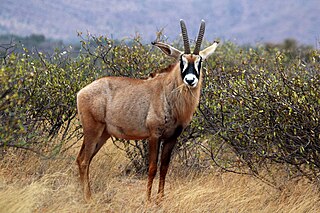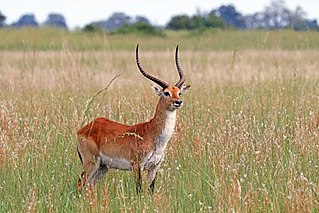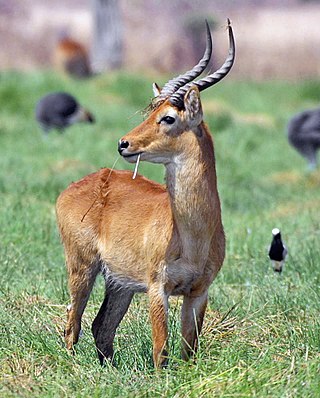
The bongo is a large, mostly nocturnal, forest-dwelling antelope, native to sub-Saharan Africa. Bongos are characterised by a striking reddish-brown coat, black and white markings, white-yellow stripes, and long slightly spiralled horns. It is the only tragelaphid in which both sexes have horns. Bongos have a complex social interaction and are found in African dense forest mosaics. They are the third-largest antelope in the world.

The term antelope refers to numerous extant or recently extinct species of the ruminant artiodactyl family Bovidae that are indigenous to most of Africa, India, the Middle East, Central Asia, and a small area of Eastern Europe. Antelopes do not form a monophyletic group, as some antelopes are more closely related to other bovid groups, like bovines, goats, and sheep, than to other antelopes.

The klipspringer is a small antelope found in eastern and southern Africa. The sole member of its genus and subfamily/tribe, the klipspringer was first described by German zoologist Eberhard August Wilhelm von Zimmermann in 1783. The klipspringer is a small, sturdy antelope; it reaches 43–60 centimetres at the shoulder and weighs from 8 to 18 kilograms. The coat of the klipspringer, yellowish gray to reddish brown, acts as an efficient camouflage in its rocky habitat. Unlike most other antelopes, the klipspringer has a thick and coarse coat with hollow, brittle hairs. The horns, short and spiky, typically measure 7.5–9 cm.

The greater kudu is a large woodland antelope, found throughout eastern and southern Africa. Despite occupying such widespread territory, they are sparsely populated in most areas due to declining habitat, deforestation, and poaching. The greater kudu is one of two species commonly known as kudu, the other being the lesser kudu, T. imberbis.

The roan antelope is a large savanna-dwelling antelope found in western, central, and southern Africa. Named for its roan colour, it has lighter underbellies, white eyebrows and cheeks and black faces, lighter in females. It has short, erect manes, very light beards and prominent red nostrils. It is one of the largest antelope, measuring 190–240 cm (75–94 in) from head to the base of the tail, and a 37–48 cm (15–19 in) long tail. Males weigh 242–300 kg (534–661 lb) and females 223–280 kg (492–617 lb). Its shoulder height is around 130–140 cm (51–55 in).

The sable antelope is a large antelope which inhabits wooded savanna in East and Southern Africa, from the south of Kenya to South Africa, with a separated population in Angola.

The hirola, also called the Hunter's hartebeest or Hunter's antelope, is a critically endangered antelope species found as of now, only in Kenya along the border of Somalia. It was first described by the big game hunter and zoologist H.C.V. Hunter in 1888. It is the only living member of the genus Beatragus, though other species are known from the fossil record. The global hirola population is estimated at 300–500 animals and there are none in captivity. According to a document produced by the International Union for Conservation of Nature "the loss of the hirola would be the first extinction of a mammalian genus on mainland Africa in modern human history".

The hartebeest, also known as kongoni or kaama, is an African antelope. It is the only member of the genus Alcelaphus. Eight subspecies have been described, including two sometimes considered to be independent species. A large antelope, the hartebeest stands just over 1 m at the shoulder, and has a typical head-and-body length of 200 to 250 cm. The weight ranges from 100 to 200 kg. It has a particularly elongated forehead and oddly-shaped horns, a short neck, and pointed ears. Its legs, which often have black markings, are unusually long. The coat is generally short and shiny. Coat colour varies by the subspecies, from the sandy brown of the western hartebeest to the chocolate brown of the Swayne's hartebeest. Both sexes of all subspecies have horns, with those of females being more slender. Horns can reach lengths of 45–70 cm (18–28 in). Apart from its long face, the large chest and the sharply sloping back differentiate the hartebeest from other antelopes. A conspicuous hump over the shoulders is due to the long dorsal processes of the vertebrae in this region.

The lechwe, red lechwe, or southern lechwe is an antelope found in wetlands of south-central Africa.

The Nile lechwe or Mrs Gray's lechwe is an endangered species of antelope found in swamps and grasslands in South Sudan and Ethiopia.

The puku is a medium-sized antelope found in wet grasslands in southern Democratic Republic of Congo, Namibia, Tanzania, Zambia and more concentrated in the Okavango Delta in Botswana. Nearly one-third of all puku are found in protected areas, zoos, and national parks due to their diminishing habitat.

The bohor reedbuck is an antelope native to central Africa. The animal is placed under the genus Redunca and in the family Bovidae. It was first described by German zoologist and botanist Peter Simon Pallas in 1767. The bohor reedbuck has five subspecies. The head-and-body length of this medium-sized antelope is typically between 100–135 cm (39–53 in). Males reach approximately 75–89 cm (30–35 in) at the shoulder, while females reach 69–76 cm (27–30 in). Males typically weigh 43–65 kg (95–143 lb) and females 35–45 kg (77–99 lb). This sturdily built antelope has a yellow to grayish brown coat. Only the males possess horns which measure about 25–35 cm (9.8–13.8 in) long.

The argali, also known as the mountain sheep, is a wild sheep that roams the highlands of western East Asia, the Himalayas, Tibet, and the Altai Mountains.

The oribi is a small antelope found in eastern, southern and western Africa. The sole member of its genus, it was described by the German zoologist Eberhard August Wilhelm von Zimmermann in 1783. While this is the only member in the genus Ourebia, eight subspecies are identified. The oribi reaches nearly 50–67 centimetres (20–26 in) at the shoulder and weighs 12–22 kilograms (26–49 lb). It possesses a slightly raised back, and long neck and limbs. The glossy, yellowish to rufous brown coat contrasts with the white chin, throat, underparts and rump. Only males possess horns; the thin, straight horns, 8–18 centimetres (3.1–7.1 in) long, are smooth at the tips and ringed at the base.

The dibatag, or Clarke's gazelle, is a medium-sized slender antelope native to Ethiopia and Somalia. Though not a true gazelle, it is similarly marked, with long legs and neck. It is often confused with the gerenuk due to their striking resemblance. The typical head-and-body length is about 103 to 117 cm. They stand up to about 80 to 90 cm. Male dibatag weigh between 20 and 35 kg, whereas females range from 22 and 29 kg. The length of the curved horns, present only on males, is typically between 10 and 25 cm. The upper parts are gray to fawn, while the dorsal and lateral areas are cinnamon to rufous. The underparts, rump and the insides of the legs are all white. While markings are visible on the face, there are none on the flanks or the buttocks.

The southern reedbuck, rietbok or common reedbuck is a diurnal antelope typically found in southern Africa. It was first described by Pieter Boddaert, a Dutch physician and naturalist, in 1785. It is placed in the genus Redunca and family Bovidae. This antelope has an average mass of 58 kg (128 lb) and a body length of about 134–167 cm (53–66 in).

Damaliscus lunatus is a large African antelope of the genus Damaliscus and subfamily Alcelaphinae in the family Bovidae, with a number of recognised geographic subspecies. Some authorities have split the different populations of the species into different species, although this is seen as controversial. Common names include topi, sassaby, tiang and tsessebe.

The Siberian ibex, also known using regionalized names including Altai ibex,Asian ibex, Central Asian ibex, Gobi ibex, Himalayan ibex, Mongolian ibex or Tian Shan ibex, is a polytypic species of ibex, a wild relative of goats and sheep. It lives in Central Asia, and is, by far, the most widely-distributed species in the genus Capra. In terms of population stability, Siberian ibex are currently ranked as Near Threatened, mostly due to over-hunting, low densities and overall decline; still, reliable data is minimal and difficult to come by, in addition to the animals’ expansive natural range, so accurate observations are still scant. The Siberian ibex has, formerly, been treated as a subspecies of the Eurasian Alpine ibex, and whether or not it is a single species or a complex of distinct units that stand out as genetically-distinct is still not entirely clear. The Siberian ibex is the longest and heaviest member of the genus Capra, though its shoulder height is slightly surpassed by the markhor.
The Mbéré Valley National Park is a national park in eastern-central Cameroon.

Heuglin's gazelle, also known as the Eritrean gazelle, is a species of gazelle found east of the Nile River in Eritrea, Ethiopia and Sudan. It was considered a subspecies of the red-fronted gazelle or conspecific with Thomson's gazelle and Mongalla gazelle by some authors in the past. This small gazelle stands nearly 67 cm (26 in) at the shoulder and weighs between 15 and 35 kg. The coat is dark reddish brown with a dark reddish stripe on the flanks, except for the underparts and the rump which are white. Horns, present in both sexes, measure 15 to 35 cm in length.
























